
The Female Siberian Ice Maiden Whose Legend Lives On
Buried in permafrost soil around the 5th century AD, a 35-year-old woman was discovered in the Republic of Altai, Russia. Finding the woman helped archaeologists develop deeper understanding of the people that lived in this remote region. The female, who is now known as the Siberian Ice Maiden was buried with a fascinating range of artifacts, all of which were remarkably preserved by the permafrost. This allowed for further information to be learned about the region and how the culture viewed death and the afterlife.
The Discovery of the Ice Maiden on the Remote Ukok Plateau
Archaeologist Dr. Natalia Polosmak headed the expedition to locate burial chambers in the Ukok region. In a 1998 interview with NOVA broadcast on PBS, Polosmak explained :
“The Pazyryk believed that after they died they would go to a mountain pasture. Ukok seemed to me the sort of place where the souls of the Pazyryk would have gathered.”
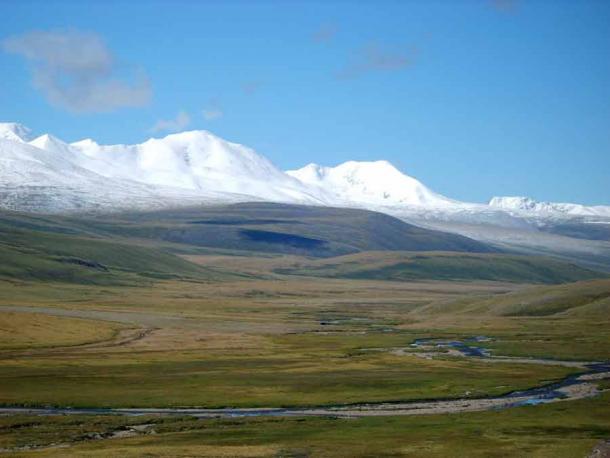
The Ukok Plateau where the Ice Maiden’s tomb was found in 1993. (Kobsev at ru.wikipedia / CC BY 2.5)
The region is surrounded by mountains and modern-day Russia, China, Kazakhstan, and Mongolia. The Ukok Plateau is part of the "Golden Mountains of Siberia," a protected UNESCO World Heritage Site since 1998. Rock carving from the Iron and Bronze Age have been found around the region, with some rock art dating back 10,000 years ago to the Paleolithic era.
- Altai Rock Art Images Reveal Insights Into Ancient Nomadic Culture
- Mummified new-born baby protected in leather shroud for 1,500 years ago found in Altai Mountains
The artifacts and discoveries in the sector have been highly preserved for over 2000 years due to the permafrost. The burials were performed high in the mountains under mounds of stones which allowed water to seep down but prevented the Sun's heat from reaching what was buried beneath. During the harsh winter conditions, the ground and the chambers would have been permanently frozen.
The Telengits, an Altaian indigenous tribe, believe that the Ukok Plateau was a place of burial and worship for their ancestors. The region is still sacred to these people. The first archeological explorations in the area started in the 1920s under the direction of Russian archaeologist Sergei Rodenko.
Some of the first cultural items discovered in the 1920s were woolen rugs, which gave an insight into these people's culture. But the 1993 discovery of the Ice Maiden’s tomb provided much more information about the culture. The artifacts found in her tomb included jewels, food, medicine, and horses.
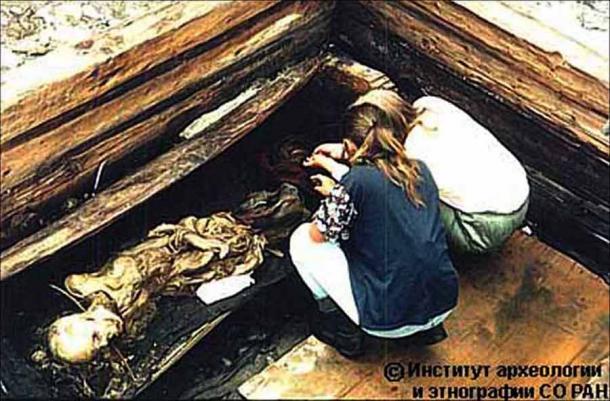
The wooden chamber where the Ice Maiden’s remains were found in 1993, as reconstructed for her museum exhibit in eastern Russia. (Siberian Times)
What Was Found in the Tomb
Discovered deep below a burial mound, the Russian archaeologists found a large wooden chamber that had been flooded with water and was permanently frozen. The outer section of the tomb revealed the remains of six frozen horses. The horses' stomachs were well preserved. This made a further analysis of the horses possible, including when they last ate.
The social status and importance of the woman were indicated by the sacrifice and burial of horses with her body. In the PBS, Polosmak stated, “These animals, no doubt of great value in their time, all had been sacrificed.”
It was believed these offerings would assist in escorting her to the next world. This was a common belief in many burial cultures around the world including the ancient Egyptians.
Next to the horses was a coffin created from a solid piece of larch wood and covered in leather appliqué deer figures. Beside the coffin were two small wooden tables believed to have been used to hold food and drinks. A wooden vessel was also found, which, based on the dairy residue inside it, likely contained yogurt.
When Polosmak and her team opened the coffin, they were disappointed to discover the inside of the coffin was completed frozen and the milky white color of the frozen mass in the coffin prevented them from seeing what was contained within.
- 5,000 Years Ago, Ancient Scientists Used Chemical Reactions to Create Pigments in Altai Mountains
- New DNA tests on ancient Denisovan people shows them occupying Altai cave 170,000 years ago
They needed to thaw out the body without harming it, and this required careful, slow melting. The method the team used was to heat water and pour a cup at a time of the hot water onto the ice block in the coffin.
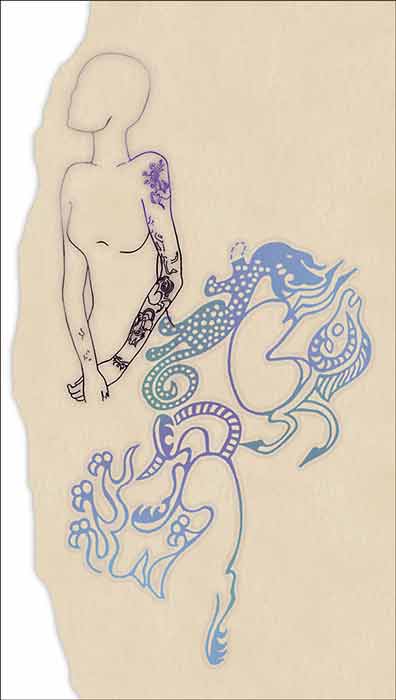
The tattoos on the body are exceptional and considered to be world class in terms of age and design. (Siberian Times)
A High-status Woman With Amazing Tattoos
Discovering that the body inside the tomb was a woman provided new insights into how women were viewed in ancient times in Siberia. Male burial tombs had been found in the region, but never a woman’s.
After her body thawed, researchers were able to look at and study her remains unhindered by the ice. One of the most shocking discoveries was her tattoos. Smoot, a researcher in the team noted in the PBS report:
“Her left arm, the right thumb, and then again on her left shoulder are these amazing tattoos. Creatures just in immediate action poses, and they are in fact twisted oddly at 180 degree angles. They have amazing horns that end in flowers, fantastic creatures.”
Her tattoos are some of the best-preserved body ink work found anywhere in the world. Tattoos were used as a form of identification, and the Pazyryk people believed that tattoos would help locate loved ones after death.
One of her most significant tattoos is believed to be a mythological animal, a deer with a griffin's beak and the antlers of Capricorn.
The tattoos also helped researchers understand the woman's social status and her age. Initial conclusions were that she was of elite status and probably quite young (around 30) when she died.
The cause of her death was not known until 2010. It is believed that she died from breast cancer and injuries from a fall. In her coffin was a container of cannabis, a drug commonly used during this time to treat chronic pain.
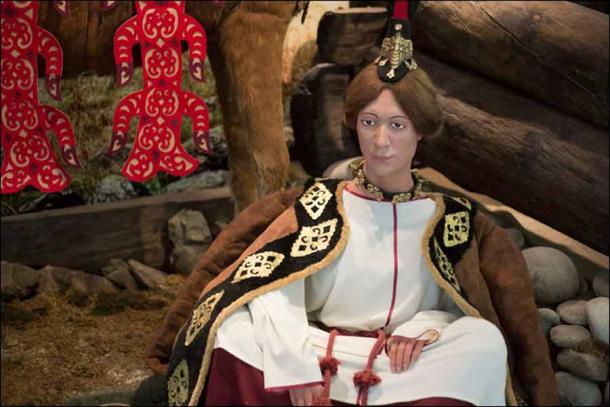
A reconstruction of what the Ice Maiden looked like, and the clothing she likely wore. (Siberian Times)
Social Status: A Female Shaman?
When the woman was discovered, researchers believed that she might have been a priestess or a shaman. This was because of items discovered in her tomb and the deer tattoos on her body.
A black felt headdress was also found in her coffin, gold leaf embroidered with what was likely a depiction of the tree of life. The patterns of fifteen types of birds were sewn into the headdress. Dr. Natalia Polosmak explained the importance of the headdress to PBS:
“There's no need to imagine how the various details were attached because it was found intact. It was also an expression of this woman's life. It showed her place in society, her family, and tribe.”
Many anthropologists believe that her elite status was not that of a princess but rather of a female shaman. Dr. Natalia Polosmak stated in the Siberian Times:
“Anthropologists believe that only her migration to the winter camp could make this seriously sick and feeble woman mount a horse. More interesting is that her kinsmen did not leave her to die, nor kill her, but took her to the winter camp.”
Her status as a shaman would explain why her kinsmen brought her to the winter camp and continued to care for her as she was dying. It was likely that her use of cannabis products to ease her pain resulted in hallucinogenic "visions." Dr. Polosmak explained Princess Tisulsky’s social status to PBS:
“This young woman, buried with such ceremony, with her body covered in tattoos, was no ordinary member of society. She may have held a special position because she was blessed with a talent valued in that society. She could have been a shaman. She may have had the ability to heal people or predict the weather.”
It became clear to the researchers that much care went into keeping the woman alive and comfortable towards the end of her life. The members of her tribe highly respected her, and carefully buried her.
She was buried with silks, gold-painted jewelry, and thigh-high riding boots.
Dr. Polosmak further explained her status: “ It was an emblem of wealth and prestige, and it's found in the burial mound of only the richest and most notable figures.”

Using MRI scans the researchers were able to learn more about the age and health of the princess. (auremar / Adobe Stock)
MRI Scans and DNA Tests Revealed Much More
When the first excavation of the tomb was underway, researchers posed many questions about this woman. Lucky with modern science, many questions were answered. The research facility in Novosibirsk, Russia, ran DNA tests, MRI scans, and even made reconstructions of the woman’s face.
Her age was one of the biggest questions. Dr Polosmak brought the deceased princess to Rudolph Hauri, a forensic pathologist in Switzerland. He examined her skull to determine her approximate age. Hauri said on PBS:
“These fissures, these are widely open on this skull. That means the skull is young—perhaps between 20 and 30.”
An MRI scan determined that she suffered from osteomyelitis, a type of bone or bone marrow infection that occurs in childhood or adolescence. They were able to determine that she likely fell from a horse resulting in a severe injury.
One of the most shocking discoveries from the MRI was evidence of breast cancer. Dr Polosmak said to the Siberian Times:
“When she was a little over 20 years old, she became ill with another serious disease - breast cancer. It painfully destroyed her.”
Further research determined that she was not buried in a line of family tombs and was separated from the other mound burials found nearby. Her separate burial suggests that Ukok women lived a more isolated life from their family and kin.
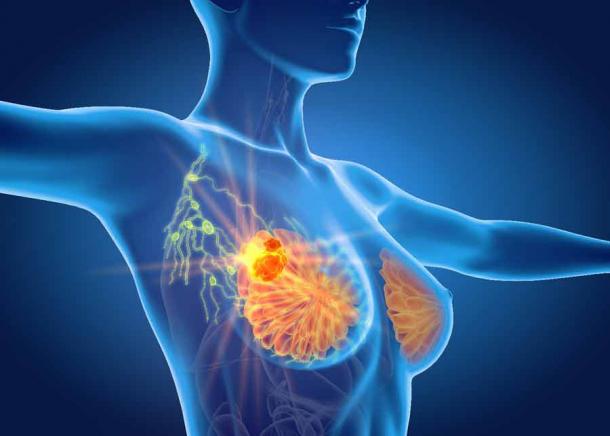
Ultimately, the princess died of breast cancer and this was proven with MRI body scans. (Axel Kock / Adobe Stock)
Breast Cancer Diagnosis
Dr. Andrey Letyagin of the Institute of Physiology and Fundamental Medicine explained to Siberian Times:
“During the imaging of mammary glands, we paid attention to their asymmetric structure and the varying asymmetry of the MRI signal. We are dealing with a primary tumor in the right breast and right axial lymph nodes with metastases.”
Her battle with stage four breast cancer would have left her weak and likely bed-bound for the last few months of her life. Researchers believe that she was brought to their winter camp in Ukok to die. While on the journey, she likely fell off her horse due to increased weakness.
In the preserved stomachs of the horses found in the tomb, the scientists found a fly larva. This type of larva is only alive at the end of June in this region, which indicated that the burial must have occurred towards the end of that month. This might have been when her kinsmen were able to dig a chamber in the defrosted ground, likely after she had passed away.
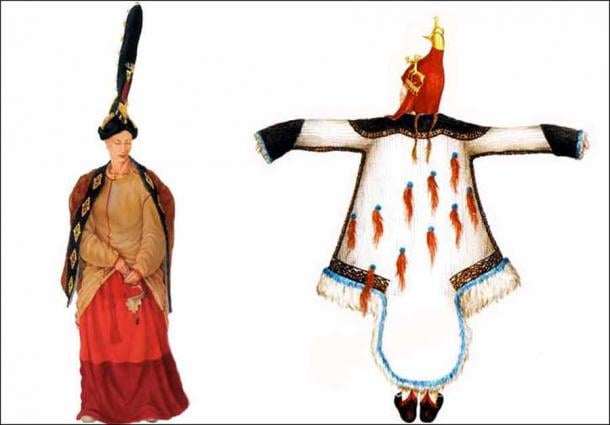
What female shamans of the period likely wore. (Siberian Times)
The Local Siberian Tribal Elders Want Their Princess Back
Many people, including the elders of the local Siberian tribes have asked that the Ice Maiden’s remains be reburied again where they were found. Many locals in the area have superstitions about what might come to pass if she is not reburied including natural disasters.
The Altai peoples believe that the maiden is one of their legendary ancestors even though modern DNA testing concluded that her remains are from the Pazyryk culture and not from the Altai culture.
- Burial Site of Siberian Archer with Intricate Arrows Unearthed in Altai Republic
- Discovery of ancient bones in Altai Mountains cave may be missing link in understanding human origins
Some reports claim that her tomb was a closed gate to the underworld and that the opening of her tomb caused the 2003 earthquake and the record floods in 2003.
Her body was stored in a research facility in Novosibirsk, Russia, from 1993 to 2014.
At present, she is housed in a special mausoleum at the Republican National Museum in Gorno-Altaisk.
The Altai clan people want her remains to be buried in her original grave and not in the mausoleum. Councilman Akay Kine of the Altai clan said this to RT News:
“The council of elders has taken its decision, so the mummy of the revered woman will finally be buried.”
However, there are no reports that this has happened as of the time of writing.
Further issues have arisen, and the Altai's local government has banned all excavations in the remote region. An elder from the Altai clan explained his frustration to the Siberian Times:
“Today, we honour the sacred beliefs of our ancestors like three millennia ago,' said one elder. 'We have been burying people according to Scythian traditions. We want respect for our traditions.”
Until her body is reburied as the elders' request, she will remain in the Republican National Museum in Gorno-Altaisk, where viewers and researchers can marvel at amazing beauty and mystery of Princess Tisulsky.
Top image: The Siberian Ice Maiden was one of the greatest archaeological discoveries of the 1990s and now, thanks to science, we know a lot more about her. Source: e_serebryakova / Adobe Stock
By Sarah Piraino
References
Lewis, S. 1998. " Ice Mummies: Siberian Ice Maiden.” PBS. Available at: https://www.pbs.org/wgbh/nova/transcripts/2517siberian.html
Liesowska, A. 2014. "Iconic 2,500 year old Siberian princess 'died from breast cancer', reveals MRI scan" The Siberian Times. Available at: http://siberiantimes.com/science/casestudy/features/iconic-2500-year-old-siberian-princess-died-from-breast-cancer-reveals-unique-mri-scan/
Siberian Times Reporter. 2012. "Siberian Princess reveals her 2,500 year old tattoos" The Siberian Times. Available at: http://siberiantimes.com/culture/others/features/siberian-princess-reveals-her-2500-year-old-tattoos/
2014. “Siberian Elders Vote to Bury 2,500 yo Mummy to Stop Quakes, Floods” RT. Available at:https://www.rt.com/news/181308-siberian-ice-maiden-bury/
2020. “Conservation of the sacred Ukok Plateau” The Altai Project. Available at: https://www.altaiproject.org/2020/12/sacred-ukok-plateau-conservation/
Polosmak, N. 1994. "A Mummy Unearthed from the Pastures of Heaven". National Geographic: 80–103. p. 87.
















Comments
People don’t change. They still make mistakes in the youth.
Nobody gets paid to tell the truth.